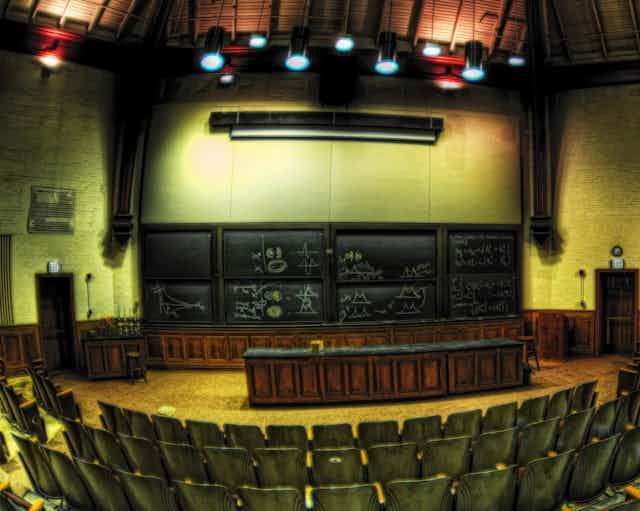Last month the University of Adelaide has boldly declared that it is phasing out lectures. Replacing them will be “flipped” classrooms, where students are expected to do pre-work before they come to class, and where classes are focussed on problem solving and collaboration.
This is only the latest phase in an ongoing movement attacking the lecture format. All around the world, the tertiary academic world is flipping its classrooms and retasking its lecturers.
This new breed of lecturers star in their own (produced and developed) five-to-seven minute videos, which are made available to students on demand and on their mobile devices.
After absorbing the densely-packed material, the students usually have to complete an online quiz before attending a workshop to demonstrate their understanding by solving practical problems.
This represents something of a paradigm shift for academia. The original concept of gathering a body of people who share a common interest into a specially designed room is being replaced by technology that allows these people to individually watch an edited version of the events on their mobile devices.
It could broadly be claimed to be one of the most significant shifts in academy history, with the humble lecture having it’s roots in medieval times. But does it make sense?
At the movies
We’ve seen an attempt at a similar shift before, when smartphones and tablets were supposed to herald the demise of the movie theatre. But that shift didn’t come to pass, and the movie industry is still thriving. Perhaps we can learn something from this in regards to lectures.
One of the appeals of the cinema is physically going to the theatre. This is a special place fit for purpose, not just any old lounge room or bedroom. Going out is an event in itself, something to be anticipated, and something that elevates its significance.

Similarly, students who actively get out of their comfortable bed and get dressed have already invested in a lecture. They are more likely to gain from it than students who minimise their effort and race through a video on a mobile device during the odd down moment.
The experience of watching a movie – even a bad one – is also enhanced when the theatre is full. Movies draw on the collective experience, as the audience gasps or laughs together. Similarly, lecture audiences can gauge if they are “getting it” along with their peers, or reinforce the solidarity of the group who value this form of learning.
In a flipped paradigm, students watch their videos in isolation with hope that others are doing the same, and are only able to rely on feedback from quizzes.
Even the process of deconstructing the movie afterwards as a group helps to reinforce the experience. This is the reason behind simultaneous blockbuster release dates. It is unlikely that such an interactive experience with peers would happen as the result of a five minute video, or the post video quiz.
Lectures don’t have to be tedious
One might observe that movies are only about interesting things and lectures are often about boring things. But people see movies about boring things too! Just try Googling “movies about statistics” (assuming you find statistics boring). There is even a movie about standard deviation!
Granted, people don’t go to a movie every day of the week. If they did, the novelty would likely wear off quickly. Similarly, it is not necessary to perform a lecture every day to ensure your audience is still engaged.
Lectures also have a great advantage over movies. The director of a movie has no ability to change the movie based on the audience reaction. On the other hand, lecturers can enthuse the audience, and they will respond. Just watch the short clip below to see an example of how a great lecturer can go beyond their physical presence to engage their audience.
Lecture theatres can be as enticing and as exciting as movie theatres. They can use state-of-the-art projection facilities and sound systems, they can bring in live experts and live crosses to things as they happen, and they can have a real live person up the front to interact with in real live time.
The audience can also interact with each other and build up their own understanding about what they are doing and its value.
The movie industry could have gone quietly to the wall when on-demand video on mobile devices became popular, but instead it recreated itself and emphasised the strengths of its format and leveraged the presence of an audience concentrating on a massive event in concert.
Before we all abandon the lecture, let us fully examine the potential that it has to make learning a social event and a strength, a place where we can all learn together.
“A thrilling, action-packed, emotionally-enriching blockbuster lecture! Coming Soon to a lecture theatre near you!”

